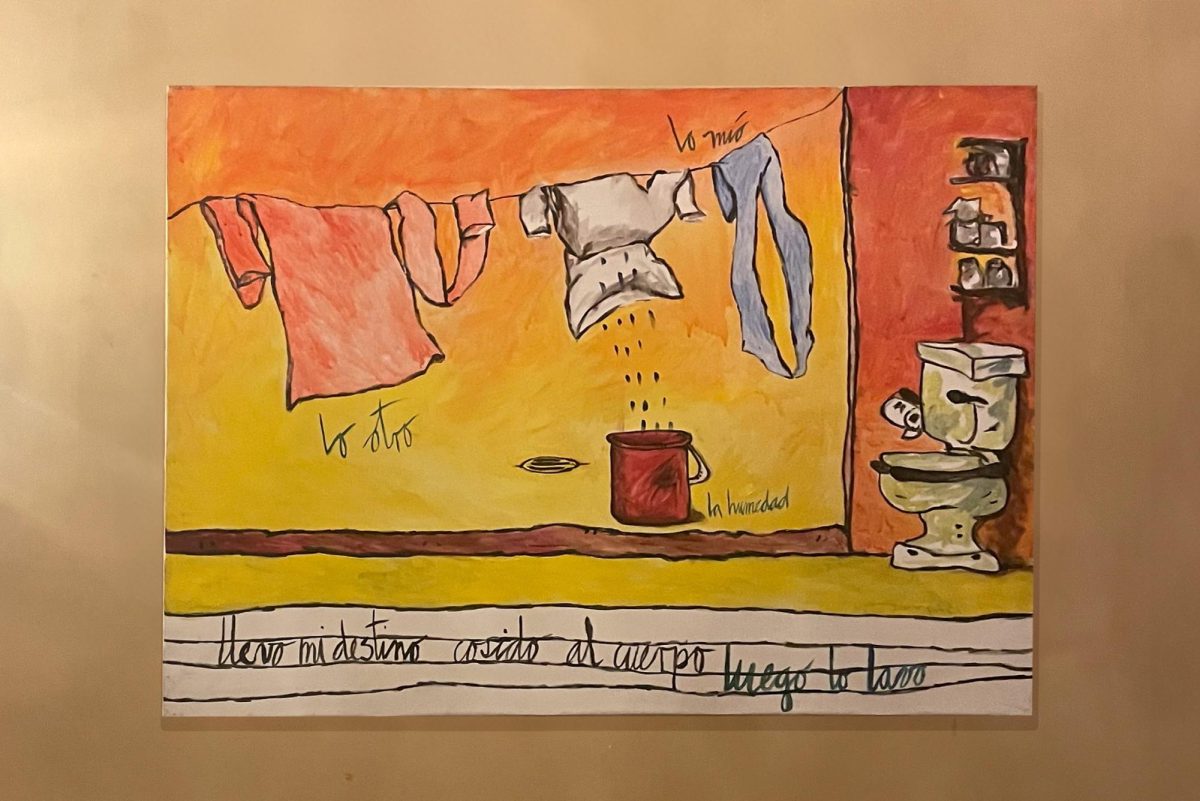In a windowless lecture hall, a solitary canvas painted with shades of yellows, pungent blues and deep reds draws the gaze of visitors. Mexican artist Magali Lara’s 1984 acrylic painting, “Guardé mi infancia (I Stored My Childhood),” brings life to a kitchen scene with a refrigerator, tabletop and a trash can, as well as two common objects in Lara’s work: windows and chairs.
“Magali Lara: Interior Landscapes” is currently on view at the James B. Duke House, which is home to NYU’s Institute of Fine Arts. Composed of four major paintings and a collection of smaller artworks, the exhibition acts as a space for Lara’s artistic autobiography.
Born in 1956 in Mexico City, Lara uses her experiences as a Mexican woman as inspiration for almost all of her works displayed at the exhibition. Within the domestic space, she subtly contemplates the traditional roles of women in Mexican culture — most notably, the role of her grandmother. Lara turns the home into a stage of cultural examination, using household objects as a form of self-introspection.
The paintings depict household furnishings, ranging from a refrigerator to a laundry line in bright colors. Lara’s style blends elements of realism with abstraction in an attempt to convey the intricacies of the female experience.
Lara’s 1984 piece “Luego lo lavo” portrays a bathroom beside a clothing line carrying a red dress, white blouse and blue tights. At the bottom of the piece is a strip of paper, resembling a notebook scrap, reading “llevo mi destino cosido al cuerpo, luego lo lavo,” which translates to “I carry my destiny sewn to the body, then I wash it.” Lara analyzes the choice within her destiny through pieces of clothing, deciding whether or not to wear them.
Transitioning from interior to exterior landscapes, Lara’s exploration of grief and the natural world is portrayed in the Loeb Room. Two abstract representations of gardens that helped her grieve her husband’s death display the bond between women and nature.
Lara’s 1995 acrylic painting, “Reproducir, repetirse” from her series “Proliferación” serves as the magnum opus of the exhibition and allows viewers to see how her aesthetics evolved. This painting is a unique addition to the exhibition as it combines two of her works. “Reproducir, repetirse” embodies a darker palette than most of her paintings with browns and deeper shades of blue, blush and green. A solitary tree stands in the middle and is surrounded by blurred natural elements.
Through botanical imagery, Lara engages her viewers beyond mere representation. Lara’s art symbolizes the passage of time and renewal by highlighting the cycles of life through the changing of seasons. She contemplates the beauty as well as the fragility of humans and nature.
The exhibition concludes with a collection of Lara’s smaller works, including a journal she created for teenage girls, a poetry book and short whimsical stories that she illustrated. Lara continues her personification of domestic items to reflect on femininity with a short story in which the protagonist, a chair, symbolizes the female body.
Through simple black and white drawings that are arranged with speech bubbles in a cartoon-like fashion, Lara shares the story of a chair falling in love as a way to discuss female desire and the place of women in society. Much like women, a chair bears weight, is leaned on and is naturally present in the domestic sphere.
Although Lara narrates her experience as a Mexican woman, the themes in her work reflect the common female experience of grappling with the expectations of women in the domestic space. The Duke House exhibition is a sincere tribute to Lara’s consideration of contemporary femininity.
“Magali Lara: Interior Landscapes” is on display at NYU’s Institute of Fine Arts through May 16.
Contact Marisa Sandoval at [email protected].























































































































































